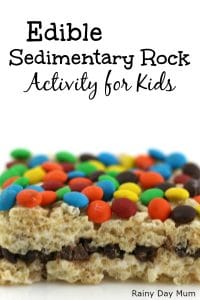Testing Soil – Simple Science for Kids
Kids love to dig in the soil and see what is there. But, soil is much much more than just something that is fun to play with as part of our rock activities for Earth Science we are looking more in depth at soil and what it’s made of. This activity is ideal for all ages of children but focuses on learning that takes place in year 3 science in the UK (7 and 8 years old).

What Is Soil?
The soil is the top part of the Earth where plants grow. This loose material is made of a combination of eroded rocks and organic matter (decaying plants and animals). The type of rocks and living organisms combined with the conditions in the area determine the type of soil you will find. The soil has different layers. If you were to dig down and cut out a cross section, you would see the layers, or horizons (humus, top soil, subsoil, and parent material).
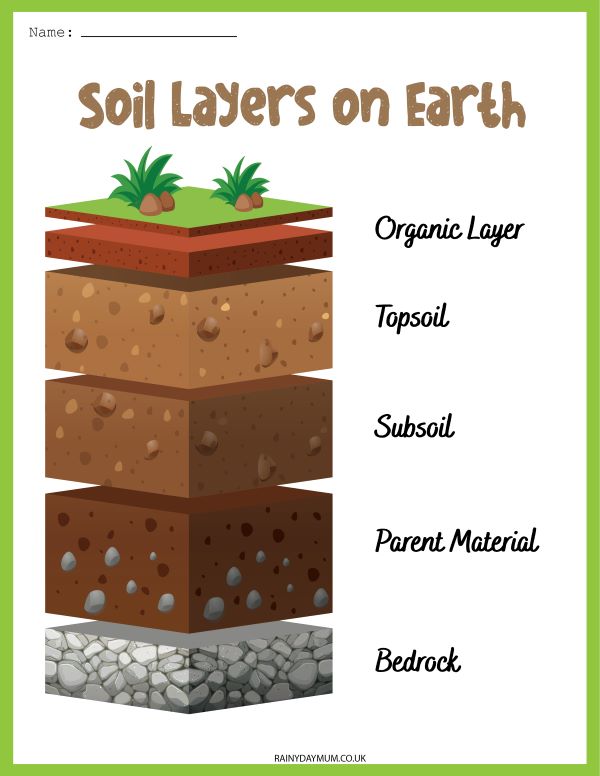
We have included affiliate links to some of the products and resources as an associate we may earn from qualifying purchases.
Exploring Types of Soil
Alongside our All about Soil Activity Pack this fun science experiment to investigate different types of soil is a great investigation for either plant science or earth science with kids.

All About Soil Printable Worksheets. Includes a soil model for reference, fill in the blank, data sheet for this experiment and more.
Supplies Needed for Soil Observations
- Different types of soil
- Peat moss
- White paper/card stock
- Magnifying glasses
- Tweezers
- Sieve
- Water and dropper to add the water slowly
- Gloves (some people are allergic to soil organisms)
I chose two locations in our backyard – one from our garden and one from a random location near the house. I dug down beneath the layer of potting soil in the garden to get soil below. I picked up a bag of peat moss at the garden center.
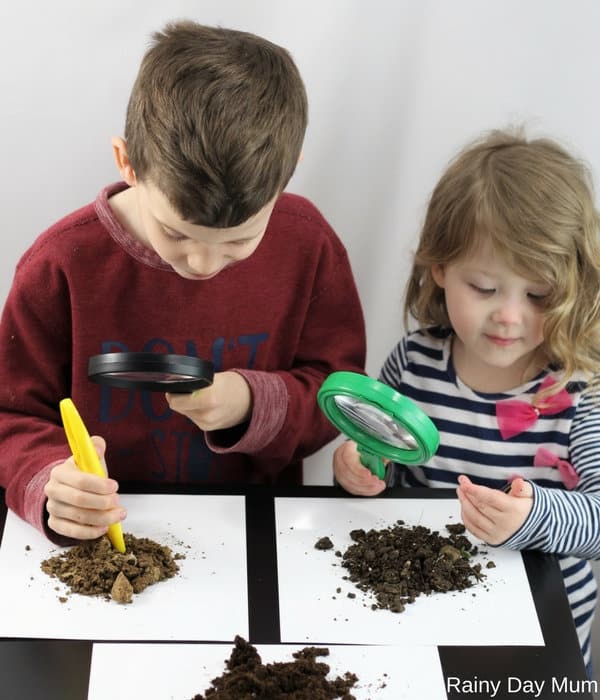
I placed a scoop of each type of soil and the peat moss on a white piece of card stock (thick paper). I talked to my kids about the soils. We had previously discussed the difference between sand, silt, clay, and humus. Soil is made of a combination of these particles. Make your own sediment jars to learn more about particle sizes. Dirt: The Scoop on Soil is a fabulous book to read and learn about what makes up soil. Making sediment jars also connects really well with learning about sedimentary rocks. Rock layers can form in a similar manner.
Questions to Ask While Observing Soil
- What color is the soil?
- What does the soil feel like? Does it feel gritty or smooth?
- Is the soil crumbly or clumpy?
- Does the soil have rocks? How about leaves or sticks?
- Can you squish the soil into a ball?
- Which soil is most like the peat moss? Why?
Use magnifying glasses, tweezers, and sieves to explore the soil.
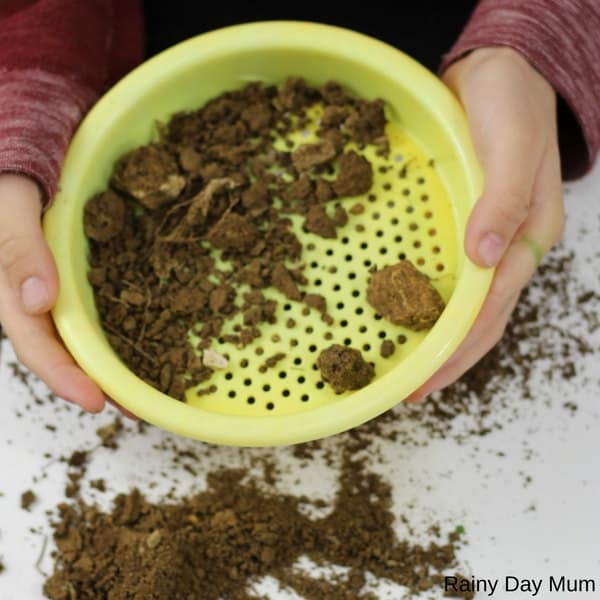
Sifting the soil will help break apart the pieces and allow you to examine it more closely.
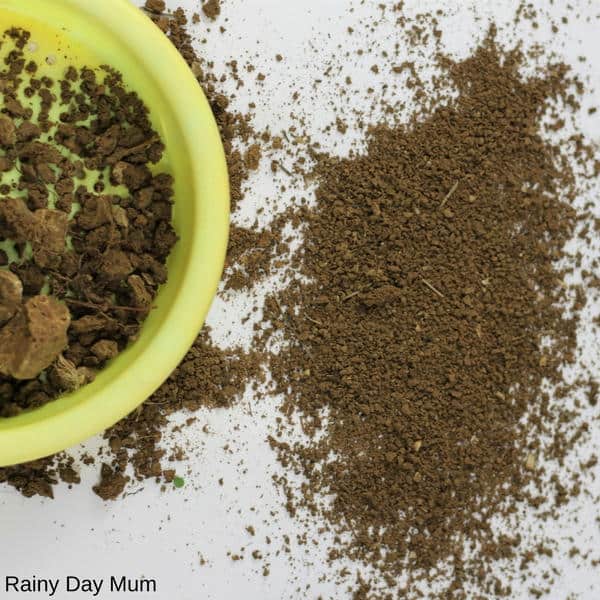
Scientists use a texture test as a quick way to identify the type of soil. Follow the directions on this guide to texture to test your own soil samples by adding a bit of water.
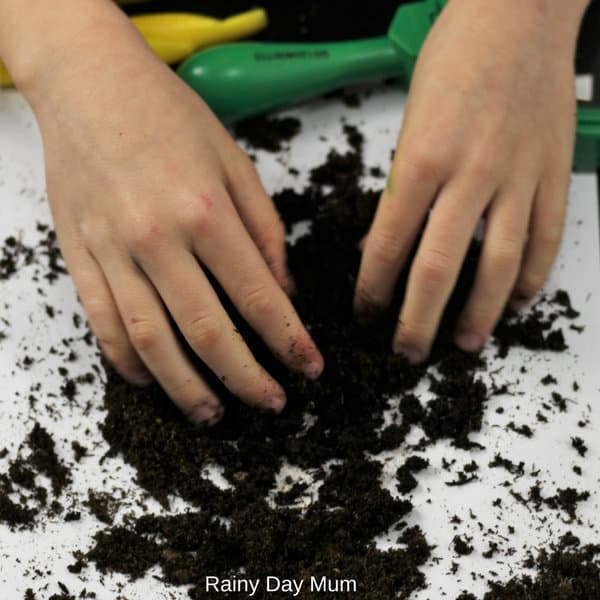
We added a bit of water to our soil samples and tried squishing them into a ribbon. We guess that our soils are some sort of silty clay.

Lastly, we looked at our peat moss. I wanted them to get to see exactly what Zoey and Sassafras used in their plant experiment. Peat moss is made of only organic matter – specifically, the decaying remains in a peat bog. It’s very nutrient rich. Gardeners love adding it to their gardens to help enrich the soil.
The texture guide doesn’t work on peat moss since it is all organic matter, but we added water to it anyway. It soaked up the water immediately. The other soil samples made mud and putty whereas the peat moss remained the same. We added a bit more water and it still soaked it in. We were able to squish the peat moss but it fell apart fairly easily. I took the opportunity to talk about the importance of organic matter in the garden. It holds water but it’s loose. This is great for plants. You can’t only have humus though. Soil needs a bit more stability and structure for the plants to grow.
More Rock and Earth Science Activities for Kids
Making Edible Sedimentary Rocks
Making Edible Metamorphic Rocks
Soil Science Inspired by Zoey and Sassafras: The Pod and The Bog

The latest instalment of Zoey and Sassafras, The Pod and The Bog (I was sent a copy for review.), finds Zoey experimenting with plants. Pip, her magical frog friend, comes across a seed pod that he has never seen before. Zoey, Sassafras, and Pip attempt to discover what the rare magical plant is so they can return it to its home. In typical Zoey fashion, this involves setting up experiments and testing out ideas (usually with a few bumps along the way). Zoey first needs to discover what type of soil the seed pod grows in. They test sand, potting mix, water, and a sand/peat moss mix. The Zoey and Sassafras series has the perfect mix of real science and magical storytelling. The Pod and The Bog is my favorite of five available so far.
Storybook Science
I love pairing books with science activities. I think it helps kids form connections and gets them excited about science. That’s why I’m happy to be hosting the Storybook Science series for a third year. During the month of March, some amazing bloggers are sharing science activities inspired by books. This week we’re focusing on Science in the Garden. Next week is all about Science with Robots.
Here our previous posts at Rainy Day Mum for the series:
- Sea Turtle Conservation.
- Rock Pooling with Kids.
- STEM Airplane Experiment.
- Can you Make the Colours of the Rainbow Sensory Bag.
- Investing the Impact of Humans on Ocean Animals – Plastic Bag Jellyfish.
Pin This Soil Science Experiment to Do Later

Share this Rock and Soil Science Experiment with Others on Facebook

Trisha Stanley
Trisha is an educator with a passion for science literacy and mom to Aiden, Lily, and Elon.
She’s the creator of Inspiration Laboratories, a blog dedicated to encouraging learning through creativity and play.


